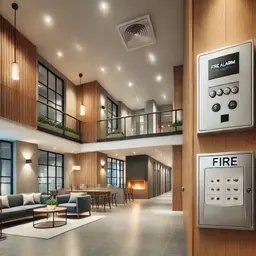
In multi-family housing complexes, ensuring the safety of residents is a top priority. These properties are home to diverse groups of people—families, professionals, and retirees—often in densely packed living spaces. In such environments, having a robust fire alarm and life safety system is not just a necessity but a critical component of responsible property management. Here’s why these systems are indispensable for multi-family housing communities.
k
k
Protecting Lives and Property
The core function of fire alarm and life safety systems is to protect lives. In multi-family housing, a single fire incident can quickly escalate, threatening hundreds of residents and causing extensive property damage. Early detection and rapid response are crucial to minimizing harm.
- Early Warning: Fire alarms provide immediate alerts, giving residents critical time to evacuate safely.
- Smoke and Heat Detection: Modern systems include smoke and heat sensors that can identify potential fires before they spread.
- Minimizing Property Damage: Faster detection and response reduce the potential for catastrophic damage, saving property owners millions in repairs.
k
k
Meeting Legal and Regulatory Requirements
Local, state, and federal regulations mandate fire alarm and life safety systems for multi-family properties. Compliance with these regulations ensures the safety of residents while avoiding costly fines and potential lawsuits.
- Building Codes: Fire alarm systems must meet standards outlined by organizations like the National Fire Protection Association (NFPA).
- Insurance Requirements: Insurance providers often require up-to-date fire safety systems to qualify for coverage or discounts.
- Tenant Safety Obligations: Property managers are legally and ethically responsible for maintaining a safe environment for tenants.
k
k
Enhanced Resident Confidence and Retention
Safety is a key factor for prospective tenants when choosing a home. A well-maintained fire alarm and life safety system can set a property apart in a competitive housing market.
- Peace of Mind: Residents are more likely to renew leases when they feel secure in their living environment.
- Positive Reputation: Properties known for prioritizing safety attract and retain high-quality tenants.
- Community Trust: Demonstrating a commitment to safety fosters trust between property managers and residents.
k
k
Advanced Features of Modern Fire Alarm Systems
Today’s fire alarm and life safety systems go beyond basic functionality. Advanced technology offers comprehensive protection and ease of management.
- Integration with Emergency Communications: Fire alarms can be integrated with emergency communication systems to provide clear evacuation instructions during crises.
- Centralized Monitoring: Cloud-based systems allow property managers to monitor multiple buildings in real time, ensuring rapid response.
- Automatic Sprinklers: Combined with fire alarms, automatic sprinklers provide an added layer of protection by controlling fires before emergency services arrive.
k
k
Addressing Unique Challenges in Multi-Family Housing
The multi-family housing industry presents unique fire safety challenges due to its size, layout, and occupancy levels. A well-designed fire alarm and life safety system can address these specific needs.
- Shared Spaces: Systems must cover common areas like lobbies, gyms, and parking garages in addition to individual units.
- High Occupancy Rates: With many residents living in close quarters, systems must prioritize efficient evacuation protocols.
- Multiple Buildings: For large complexes, centralized fire safety systems ensure seamless management across all structures.
k
k
Emerging Trends in Fire and Life Safety for Multi-Family Housing
The fire safety industry is constantly evolving to meet the demands of modern housing. Here are some emerging trends that are shaping the future:
- Smart Fire Alarms: Connected systems use IoT technology to send alerts directly to property managers’ smartphones.
- AI-Powered Detection: Artificial intelligence enhances detection capabilities, identifying fire risks faster and with greater accuracy.
- Green Building Integration: Fire safety systems are being designed to align with sustainable building practices, minimizing energy use and waste.
- Personalized Alerts: Systems can now provide targeted alerts to specific residents based on their location within the property.
k
k
Benefits of Fire Alarm and Life Safety Systems
Investing in a comprehensive fire alarm and life safety system delivers numerous benefits for property managers and residents alike:
- Faster Emergency Response: Immediate alerts ensure emergency services are dispatched quickly.
- Reduced Liability: Meeting safety standards protects property owners from legal and financial repercussions.
- Lower Insurance Costs: Properties with advanced fire safety systems may qualify for lower premiums.
- Community Resilience: A strong safety infrastructure helps communities recover more quickly from emergencies.
k
k
Conclusion
Fire alarm and life safety systems are a non-negotiable component of multi-family housing management. They protect lives, reduce property damage, and ensure compliance with legal standards while enhancing tenant confidence and retention. As the industry evolves, adopting advanced systems with integrated features will be essential for staying ahead of safety challenges.
If you're looking to upgrade or install fire alarm and life safety systems in your multi-family property, SSP can help. Contact us today to learn more about how we can create a customized solution for your needs.


